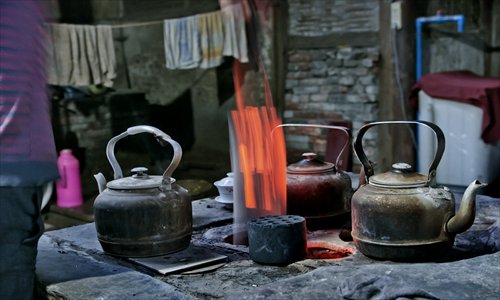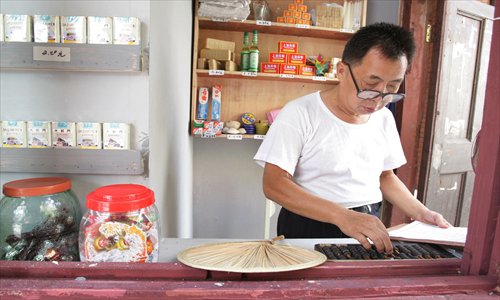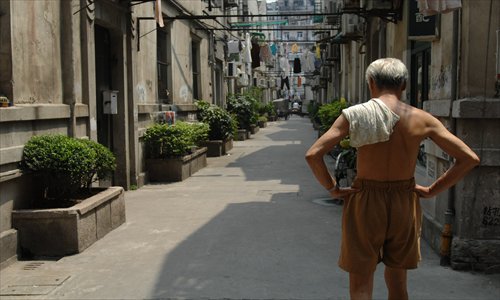Behind the gates
Editor's note
From a fishing village with a population of just 200,000 in 1843, Shanghai has developed into a huge modern city where more than 23 million people live. From the time Shanghai was forced to open up as a port in 1843, the city has witnessed remarkable change and progress. This year marks the 171st anniversary of Shanghai's opening-up and in this special series of reports, the Global Times will highlight some of the crucial moments, recall some choice memories of olden days and uncover some of the secrets of the city. Don't miss these exciting insights into the metropolis.

Two of the most distinctive features of Shanghai are the architectural and street designs - the blend of European and Chinese influences that sprang up after the 1840s when the city was opened up to Western culture and trade. The most notable of these features were the longtang, the alleyways, where the shikumen, the "stone gate" houses, stood shoulder to shoulder, accommodating the citizens.
The longtang first appeared in the former British concession and they were home to most Shanghainese until the 1990s. The gateways were typically large wooden doors with ornate bronze rings, framed by stonework and crowned with an often classically decorated stone or wood lintel which often reflected the European or Chinese aspirations of the families inside.
Shanghai swelled with migrants wanting to live here, first as a result of the trade from the opening up and then refugees in the 1860s, the result of the Taiping Rebellion. As the city grew and grew more prosperous, the longtang and shikumen became the way of life, a predecessor of Western gated communities.
In Shanghai prominent shikumen longtang included Yanqingli on Xiamen Road and Jixiangli on Henan Road Middle which were built in the early 1900s. This early style of shikumen longtang has practically vanished.
Modern features
Most of the longtang remaining are classified as late shikumen longtang and they included modern features. Xingyeli on Xingye Road, the site of the First National People's Congress of the Communist Party of China, is a typical late shikumen longtang.
While the architecture of these old buildings remains in place, the longtang lifestyle is only a memory for many. Older residents still recall with affection the way people would gather to enjoy tea or to buy hot water at a laohuzao, a tiger stove. These laohuzao were located in stores in longtang and often also served as teahouses and bathhouses.
Reportedly laohuzao dated back to the 1850s when wood and coal were the only available fuel sources, and when it was impossible for people to boil water at home. These shops became an indispensable part of daily life.
The tiger stoves have openings shaped like the eyes of a tiger and the chimney could be representative of a tail, although others say the word laohuzao sounds like "roof" in English - these shops were always found in Western-style premises with roofs and chimneys.
In the 1950s when laohuzao was in its heyday, there were more than 2,000 laohuzao stores around the city.
Older citizens recall watching the hot water pour out of taps wrapped in cotton to prevent the water splashing and burning customers or staff. Customers lined up with thermos flasks, kettles and pots. One bottle of hot water cost 1 fen (10 fen equaled 1 jiao or $0.017). The cotton wrappings regularly became rusted and were replaced.

Winter queues
Some of the laohuzao stores were quite large and provided tables where people could sit and chat over tea. In a longtang in winter there were always queues of people outside the laohuzao waiting to buy hot water - the stores opened from 6 am till 10 pm.
With the arrival of gas and electricity in the city and improved water supplies, the laohuzao stores died out and are now nearly all extinct. In recent years, the cost of running these hot water supply stores and the air pollution that burning wood can cause has practically ended the laohuzao and very few can be found today, certainly none in the downtown area.
Another disappearing tradition for city folk is the public bathhouse which also arrived on the scene in the 1840s. In the old days the Shanghai public bathhouses, huntang, were mixed bathing pools. People from all walks of life bathed together, naked. By the end of the day, as the water was not changed, the bath was pretty murky. In Chinese the word hun can also mean dirty or murky but the signs for the huntang never actually used this word - most bathhouses were advertised as fresh natural spring. The water for the bath was heated in an adjacent boiler and piped into the main pool.
In a bathhouse there were different pools for different purposes. Larger pools were filled with warm water for bathing but smaller pools had hot water and were used for cleaning the feet. Bathhouses offered extra services like back rubs, massages, haircuts and pedicures.
After a bath, a customer could lie facedown while an assistant would rub his back and body with a loofah. Apparently the rougher the treatment the better - customers enjoyed the feeling of their skin being rubbed nearly raw.
There was a saying in old Shanghai: "In the morning, the body takes water but in the evening, water takes the body" - people drink tea in the morning and have a bath in the evening.
A big tradition in Shanghai was having a bath and haircut before the Chinese New Year. So every year, the days between December 20 and the Chinese New Year's Eve were the busiest period for huntang. Wily customers often bribed bathhouse workers to get in and have a bath in clean water before the bathhouse officially opened in the morning.

Women only
The first women-only public bathhouse, the Longquan Household Women's Bathhouse opened in 1926. But the women's bathhouses had problems - they were not as popular as the general bathhouses and many were used by prostitutes. Other Western style bathhouses also opened around the city, some offering Turkish or Finnish style baths and massages and some offering prostitutes as part of the service.
Bathhouses also attracted a number of lowlife clientele and thefts and assaults were often reported.
The famous Chinese artist Pan Yuliang won the gold prize at the Roman International Art Exhibition in 1926 with her paintings of nudes. When she was in Shanghai the authorities forbade nude models, so Pan went to bathhouses, remembering carefully the shapes and forms of the people she observed and copying her memories down afterwards. Her fine sketches and paintings created a controversy and in 1937 she moved to live and work in Paris.
Another fan of the Shanghai Bathhouses was the Qing Dynasty (1644-1911) diplomat Li Hongzhang, who moved to the city in 1864. Afflicted with painful corns and calluses on his feet he found relief after years of suffering when a city bathhouse pedicurist removed the growths. Li reportedly gave the pedicurist a large reward.
Shanghai had a form of 24-hour convenience stores long before the West. Known as yanzhidian, stories, pictures and cartoons of these small stores were common in newspapers in the 1920s. Until the 1940s these shops thrived and could be found in almost any Shanghai longtang.
Yanzhidian (literally tobacco and paper shops) sold toothpaste, soap, tissues, light bulbs, candy and snacks. Many Shanghai people have fond memories of spending their pocket money on ice creams, candy and snacks at a small yanzhidian.
These convenience stores were usually run by a husband and wife. The wife often looked after the shop during the day while the husband worked elsewhere. Children and grandparents also helped out.
The shops were actually part of their homes so that customers could see the shop owners' home lives behind the counters. Stores like this were found at the ends of a longtang.
After hours
Although officially they opened at 6 am and closed at 10 pm customers who wanted something after-hours only had to knock on the door and someone would sell them what they needed through a small aperture.
These stores also helped customers by changing money, small bills for larger notes. And when telephones arrived in Shanghai this was where they were usually located in a longtang. The shopkeepers would go into the lane way and yell out the names of people who were wanted by a caller.
The shopkeepers knew everyone closely and also kept an eye on strangers who walked into the longtang. Although these have been replaced with modern convenience stores they were very much a part of Shanghai and longtang life.